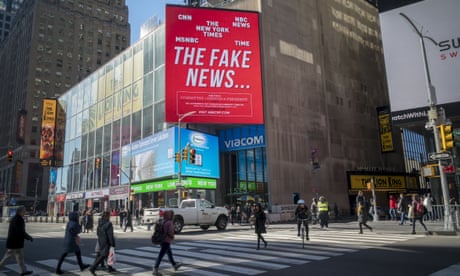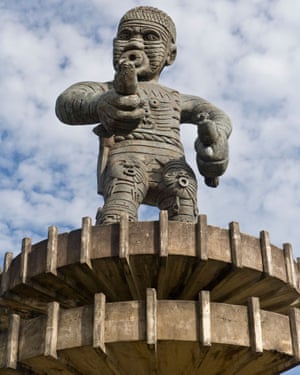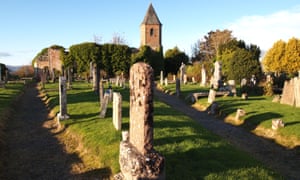Despite owning 15,000 hectares (37,000 acres) of land, managing a property portfolio worth £2.3bn and having control over huge swaths of central Manchester and Liverpool, very few people have heard of a company named Peel Holdings. It owns the Manchester Ship Canal. It built the Trafford Centre shopping complex and, more recently, sold it in the largest single property acquisition in Britain’s history. It was the developer behind the MediaCityUK site in Salford, to which the BBC and ITV have relocated many of their operations in recent years. Airports, fracking, retail – the list of Peel business interests stretches on and on.
Peel Holdings operates behind the scenes, quietly acquiring land and real estate, cutting billion-pound deals and influencing numerous planning decisions. Its investment decisions have had an enormous impact, whether for good or ill, on the places where millions of people live and work.
Peel’s ultimate owner, the billionaire John Whittaker, is notoriously publicity-shy: he lives on the Isle of Man, has never given an interview and helicopters into his company’s offices for board meetings. He built Peel Holdings in the 1970s and 80s by buying up a series of companies whose fortunes had decayed, but which still controlled valuable land. Foremost among these was the Manchester Ship Canal Company, purchased in 1987. The canal turned out to be valuable not simply as a freight route, but also because of the redevelopment potential of the land that flanked it.

Half of England is owned by less than 1% of the population
Peel Holdings tends not to show its hand in public. Like many companies, it prefers its forays into public political debate to be conducted via intermediary bodies and corporate coalitions. In 2008, it emerged that Peel was a dominant force behind a business grouping that had formed to lobby against Manchester’s proposed congestion charge. The charge was aimed at cutting traffic and reducing the toxic car fumes choking the city. But Peel, as owners of the out-of-town Trafford Centre shopping mall, feared that a congestion charge would be bad for business, discouraging shoppers from driving through central Manchester to reach the mall. Peel’s lobbying paid off: voters rejected the charge in the local referendum and the proposal was dropped.
Throughout England, cash-strapped councils are being outgunned by corporate developers pressing to get their way. The situation is exacerbated by a system that has allowed companies like Peel to keep their corporate structures obscure and their landholdings hidden. A 2013 report by Liverpool-based thinktank Ex Urbe found “well in excess of 300 separately registered UK companies owned or controlled” by Peel. Tracing the conglomerate’s structure is an investigator’s nightmare. Try it yourself on the Companies House website: type in “Peel Land and Property Investments PLC”, and then click through to persons with significant control. This gives you the name of its parent company, Peel Investments Holdings Ltd. So far, so good. But then repeat the steps for the parent company, and yet another holding company emerges; then another, and another. It’s like a series of Russian dolls, one nested inside another.
Until recently, it was even harder to get a handle on the land Peel Holdings owns. Sometimes the company has provided a tantalising glimpse: one map it produced in 2015, as part of some marketing spiel around the “northern powerhouse”, showcases 150 sites it owns across the north-west. It confirms the vast spread of Peel’s landed interests – from Liverpool John Lennon airport, through shale gas well pads, to one of the UK’s largest onshore wind farms. But it’s clearly not everything. A more exhaustive, independent list of the company’s landholdings might allow communities to be forewarned of future developments. As Ex Urbe’s report on Peel concludes: “Peel schemes rarely come to light until they are effectively a fait accompli and the conglomerate is confident they will go ahead, irrespective of public opinion.”
While Peel Holdings is unusual for the sheer amount of land it controls, it is also illustrative of corporate landowners everywhere. Corporations looking to develop land have numerous tricks up their sleeve that they can use to evade scrutiny and get their way, from shell company structures to offshore entities. Companies with big enough budgets can often ride roughshod over the planning system, beating cash-strapped councils and volunteer community groups. And companies have for a long time benefited from having their landholdings kept secret, giving them the element of surprise when it comes to lobbying councils over planning decisions and the use of public space. But now, at long last, that is starting to change. If we want to “take back control” of our country, we need to understand how much of it is currently controlled by corporations.
In 2015, the Private Eye journalist Christian Eriksson lodged a freedom of information (FOI) request with the Land Registry, the official record of land ownership in England and Wales. He asked it to release a database detailing the area of land owned by all UK-registered companies and corporate bodies. Eriksson later shared this database with me, and what it revealed was astonishing. Here, laid bare after the dataset had been cleaned up, was a picture of corporate control: companies today own about 2.6m hectares of land, or roughly 18% of England and Wales.
In the unpromising format of an Excel spreadsheet, a compelling picture emerged. Alongside the utilities privatised by Margaret Thatcher and John Major – the water companies, in particular – and the big corporate landowners, were PLCs with multiple shareholders. There were household names, such as Tesco, Tata Steel and the housebuilder Taylor Wimpey, and others more obscure. MRH Minerals, for example, appeared to own 28,000 hectares of land, making it one of the biggest corporate landowners in England and Wales.
Gradually, I pieced together a list of what looked to be the top 50 landowning companies, which together own more than 405,000 hectares of England and Wales. Peel Holdings and many of its subsidiaries, unsurprisingly, feature high on the list. But while the dataset revealed in stark detail the area of land owned by UK-based companies, it did nothing to tell us what they owned, and where.
That would take another two years to emerge. Meanwhile, Eriksson had been busy at work with his Private Eye colleague Richard Brooks and the computer programmer Anna Powell-Smith, delving into another form of corporate landowner – firms based overseas, yet owning land in the UK. Of particular interest were companies based in offshore tax havens, a wholly legal but controversial practice, given the opportunities offshore ownership gives for possible tax avoidance and for concealing the identities of who ultimately controls a company. Further FOI requests to the Land Registry by Eriksson hit the jackpot when he was sent – “accidentally”, the Land Registry would later claim – a huge dataset of overseas and offshore-registered companies that had bought land in England and Wales between 2005 and 2014: some 113,119 hectares of land and property, worth a staggering £170bn.
Victoria Harbour building at Salford Quays, owned by Peel Holdings. Photograph: Mike Robinson/Alamy
Private Eye’s work revealed that a large chunk of the country was not only under corporate control, but owned by companies that – in many cases – were almost certainly seeking to avoid paying tax, that most basic contribution to a civilised society. Some potentially had an even darker motive: purchasing property in England or Wales as a means for kleptocratic regimes or corrupt businessmen to launder money, and to get a healthy return on their ill-gotten gains in the process. This was information that clearly ought to be out in the open, with a huge public interest case for doing so. And yet the government had sat on it for years.
The political ramifications of these revelations were profound. They kickstarted a process of opening up information on land ownership that, although far slower and less complete than many would have liked, has nevertheless transformed our understanding of what companies own. In November 2017, the Land Registry released its corporate and commercial dataset, free of charge and open to all. It revealed, for the first time, the 3.5m land titles owned by UK-based corporate bodies – covering both public sector institutions and private firms – with limited companies owning the majority, 2.1m, of these. But there were two important caveats. Although we now had the addresses owned by companies, the dataset omitted to tell us the size of land they owned. Second, the data lacked accurate information on locations, making it hard to map.
Despite this, what can we now say about company-owned land in England and Wales? Quite a lot, it turns out. We know, for example, that the company with the third-highest number of land titles is the mysterious Wallace Estates, a firm with a £200m property portfolio but virtually no public presence, and which is owned ultimately by a secretive Italian count. Wallace Estates makes its money from the controversial ground rents market, whereby it owns thousands of freehold properties and sells on long leases with annual ground rents.
We also now know that Peel Holdings and its numerous subsidiaries owns at least 1,000 parcels of land across England – not just shopping centres and ports in the north-west, but also a hill in Suffolk, farmland along the Medway and an industrial estate in the Cotswolds. Councils, MPs and residents wanting to keep an eye on what developers and property companies are up to in their area now have a powerful new tool at their disposal.
The data is full of odd quirks and details. Who would have guessed, for instance, that the arms manufacturer BAE owns a nightclub in Cardiff, a pub on Blackpool’s promenade and a service station in Pease Pottage, Sussex? It turns out that they are all investments made by BAE’s pension fund; if selling missiles to Saudi Arabia doesn’t prove profitable enough, it appears the company’s strategy is to make a few quid out of tired drivers stopping for a coffee break off the M23.
The data also lets us peer into the property acquisitions of the big supermarkets, which back in the 1990s and early 2000s involved building up huge land banks to construct ever more out-of-town retail parks. Tesco, via a welter of subsidiaries, owns more than 4,500 hectares of land – and although much of this comprises existing stores, a good chunk also appears to be empty plots, apparently earmarked for future development. One analysis by the Guardian in 2014 estimated that the supermarket was hoarding enough land to accommodate 15,000 homes. More recently, however, Tesco’s financial travails have prompted it to sell off some of its sites. Internet shopping and pricier petrol have made giant hypermarkets built miles from where people live look less and less like smart investments. In 2016, Tesco’s beleaguered CEO announced the company was looking to make better use of the land it owned by selling it for housing, and even by building flats on top of its superstores. As for the supermarkets’ internet shopping rival Amazon, whose gigantic “fulfilment centres” resemble the vast US government warehouse at the end of Raiders of the Lost Ark – well, Amazon currently has 16 of those across the UK. And it has grown very quickly: all but one of its property leases have been bought in the past decade.
Companies are increasingly taking over previously public space in cities, too. Recent years have seen a proliferation of Pops – privately owned public spaces – as London, Manchester and other places redevelop and gentrify. You know the sort of thing: expensively landscaped swaths of “public realm”. Aesthetically, they are all very nice, but try to use Pops for some peaceful protest, and you are in for trouble. They are invariably governed by special bylaws and policed by private security, itching to get in your face. I once found this to my cost when staging a tiny, two-person anti-fracking demo outside shale-gas financiers Barclays bank in Canary Wharf. Canary Wharf is partly owned by the Qatari Investment Authority, and – bizarrely – photography is banned. Within a minute of us taking the first selfie on our innocuous protest, security guards had descended en masse, and we spent the next hour running around Canary Wharf trying to evade them.
The Land Registry’s corporate ownership dataset contains millions of entries, and much remains to be uncovered. Some of the information appears trivial at first glance – a company owns a factory here, an office there: so what? But as more people pore over the data, more stories will likely emerge. Future researchers might find intriguing correlations between the locations of England’s thousands of fast-food stores and the health of nearby populations, be able to track gentrification through the displacement of KFC outlets by Nando’s restaurants, and so on.
But to really get under the skin of how companies treat the land they own, and the wider repercussions, we need to zoom in on the housing sector, where debates about companies involved in land banking and profiteering from land sales are crucial to our understanding of the housing crisis.
One particularly controversial aspect of the housing debate that has generated much heat, and little light, in recent years is the debacle over land banking, the practice of hoarding land and holding it back from development until its price increases.
In 2016, the then housing secretary, Sajid Javid, furiously accused large housing developers of land banking and demanded they “release their stranglehold” on land supply. Housebuilders, not used to such impertinence from a Conservative minister, hit back. “As has been proved by various investigations in the past, housebuilders do not land bank,” a spokesperson for the Home Builders Federation told the Telegraph. “In the current market where demand is high, there is absolutely no reason to do so.”
So who is right? This is a complex area, but one that is important to investigate. Can the Land Registry’s corporate ownership data help us get to the bottom of it?
It is common for UK pension funds and insurance companies to buy up land as a long-term strategic investment. Legal & General, for example, owns 1,500 hectares of land that it openly calls a “strategic land portfolio … stretching from Luton to Cardiff”. Its rationale for buying land is simple: “Strategic land holdings are underpinned by their existing use value [such as farming] and give us the opportunity to create further value through planning promotion and infrastructure works over the medium to long term.”
When I looked into where Legal & General’s land was located, I noticed something odd. Nearly all of it lay within green belt areas, where development is restricted. The company appears to have bought it with the aim of lobbying councils to ultimately rip up such restrictions and redesignate the site for development in future.
In the case of pension funds lobbying to rip up the green belt, it’s the planning system that is (rightly) constraining development, not land banking itself. And none of this implicates the usual bogeymen of the housing crisis, the big housebuilding companies. By examining what these major developers own, is it possible to say whether they’re actively engaged in land banking?
There is no doubt that many of the major housebuilding companies own a lot of land. What’s more, housing developers themselves talk about their “current land banks” and publish figures in annual reports listing the number of homes they think they can build using land where they have planning permission. As the housing charity Shelter has found, the top 10 housing developers have land banks with space for more than 400,000 homes – about six years’ supply at current building rates.
Prompted by such statistics, the government ordered a review into build-out rates in 2017, led by Sir Oliver Letwin. Yet when Letwin delivered his draft report, he once again exonerated housebuilders from the charge of land banking. “I cannot find any evidence that the major housebuilders are financial investors of this kind,” he stated, pointing the finger of blame instead at the rate at which new homes could be absorbed into the marketplace.
Part of the problem is that the data on what companies own still isn’t good enough to prove whether or not land banking is occurring. The aforementioned Anna Powell-Smith has tried to map the land owned by housing developers, but has been thwarted by the lack in the Land Registry’s corporate dataset of the necessary information to link data on who owns a site with digital maps of that area. That makes it very hard to assess, for example, whether a piece of land owned by a housebuilder for decades is a prime site accruing in value or a leftover fragment of ground from a past development.
Private Eye’s work revealed that a large chunk of the country was not only under corporate control, but owned by companies that – in many cases – were almost certainly seeking to avoid paying tax, that most basic contribution to a civilised society. Some potentially had an even darker motive: purchasing property in England or Wales as a means for kleptocratic regimes or corrupt businessmen to launder money, and to get a healthy return on their ill-gotten gains in the process. This was information that clearly ought to be out in the open, with a huge public interest case for doing so. And yet the government had sat on it for years.
The political ramifications of these revelations were profound. They kickstarted a process of opening up information on land ownership that, although far slower and less complete than many would have liked, has nevertheless transformed our understanding of what companies own. In November 2017, the Land Registry released its corporate and commercial dataset, free of charge and open to all. It revealed, for the first time, the 3.5m land titles owned by UK-based corporate bodies – covering both public sector institutions and private firms – with limited companies owning the majority, 2.1m, of these. But there were two important caveats. Although we now had the addresses owned by companies, the dataset omitted to tell us the size of land they owned. Second, the data lacked accurate information on locations, making it hard to map.
Despite this, what can we now say about company-owned land in England and Wales? Quite a lot, it turns out. We know, for example, that the company with the third-highest number of land titles is the mysterious Wallace Estates, a firm with a £200m property portfolio but virtually no public presence, and which is owned ultimately by a secretive Italian count. Wallace Estates makes its money from the controversial ground rents market, whereby it owns thousands of freehold properties and sells on long leases with annual ground rents.
We also now know that Peel Holdings and its numerous subsidiaries owns at least 1,000 parcels of land across England – not just shopping centres and ports in the north-west, but also a hill in Suffolk, farmland along the Medway and an industrial estate in the Cotswolds. Councils, MPs and residents wanting to keep an eye on what developers and property companies are up to in their area now have a powerful new tool at their disposal.
The data is full of odd quirks and details. Who would have guessed, for instance, that the arms manufacturer BAE owns a nightclub in Cardiff, a pub on Blackpool’s promenade and a service station in Pease Pottage, Sussex? It turns out that they are all investments made by BAE’s pension fund; if selling missiles to Saudi Arabia doesn’t prove profitable enough, it appears the company’s strategy is to make a few quid out of tired drivers stopping for a coffee break off the M23.
The data also lets us peer into the property acquisitions of the big supermarkets, which back in the 1990s and early 2000s involved building up huge land banks to construct ever more out-of-town retail parks. Tesco, via a welter of subsidiaries, owns more than 4,500 hectares of land – and although much of this comprises existing stores, a good chunk also appears to be empty plots, apparently earmarked for future development. One analysis by the Guardian in 2014 estimated that the supermarket was hoarding enough land to accommodate 15,000 homes. More recently, however, Tesco’s financial travails have prompted it to sell off some of its sites. Internet shopping and pricier petrol have made giant hypermarkets built miles from where people live look less and less like smart investments. In 2016, Tesco’s beleaguered CEO announced the company was looking to make better use of the land it owned by selling it for housing, and even by building flats on top of its superstores. As for the supermarkets’ internet shopping rival Amazon, whose gigantic “fulfilment centres” resemble the vast US government warehouse at the end of Raiders of the Lost Ark – well, Amazon currently has 16 of those across the UK. And it has grown very quickly: all but one of its property leases have been bought in the past decade.
Companies are increasingly taking over previously public space in cities, too. Recent years have seen a proliferation of Pops – privately owned public spaces – as London, Manchester and other places redevelop and gentrify. You know the sort of thing: expensively landscaped swaths of “public realm”. Aesthetically, they are all very nice, but try to use Pops for some peaceful protest, and you are in for trouble. They are invariably governed by special bylaws and policed by private security, itching to get in your face. I once found this to my cost when staging a tiny, two-person anti-fracking demo outside shale-gas financiers Barclays bank in Canary Wharf. Canary Wharf is partly owned by the Qatari Investment Authority, and – bizarrely – photography is banned. Within a minute of us taking the first selfie on our innocuous protest, security guards had descended en masse, and we spent the next hour running around Canary Wharf trying to evade them.
The Land Registry’s corporate ownership dataset contains millions of entries, and much remains to be uncovered. Some of the information appears trivial at first glance – a company owns a factory here, an office there: so what? But as more people pore over the data, more stories will likely emerge. Future researchers might find intriguing correlations between the locations of England’s thousands of fast-food stores and the health of nearby populations, be able to track gentrification through the displacement of KFC outlets by Nando’s restaurants, and so on.
But to really get under the skin of how companies treat the land they own, and the wider repercussions, we need to zoom in on the housing sector, where debates about companies involved in land banking and profiteering from land sales are crucial to our understanding of the housing crisis.
One particularly controversial aspect of the housing debate that has generated much heat, and little light, in recent years is the debacle over land banking, the practice of hoarding land and holding it back from development until its price increases.
In 2016, the then housing secretary, Sajid Javid, furiously accused large housing developers of land banking and demanded they “release their stranglehold” on land supply. Housebuilders, not used to such impertinence from a Conservative minister, hit back. “As has been proved by various investigations in the past, housebuilders do not land bank,” a spokesperson for the Home Builders Federation told the Telegraph. “In the current market where demand is high, there is absolutely no reason to do so.”
So who is right? This is a complex area, but one that is important to investigate. Can the Land Registry’s corporate ownership data help us get to the bottom of it?
It is common for UK pension funds and insurance companies to buy up land as a long-term strategic investment. Legal & General, for example, owns 1,500 hectares of land that it openly calls a “strategic land portfolio … stretching from Luton to Cardiff”. Its rationale for buying land is simple: “Strategic land holdings are underpinned by their existing use value [such as farming] and give us the opportunity to create further value through planning promotion and infrastructure works over the medium to long term.”
When I looked into where Legal & General’s land was located, I noticed something odd. Nearly all of it lay within green belt areas, where development is restricted. The company appears to have bought it with the aim of lobbying councils to ultimately rip up such restrictions and redesignate the site for development in future.
In the case of pension funds lobbying to rip up the green belt, it’s the planning system that is (rightly) constraining development, not land banking itself. And none of this implicates the usual bogeymen of the housing crisis, the big housebuilding companies. By examining what these major developers own, is it possible to say whether they’re actively engaged in land banking?
There is no doubt that many of the major housebuilding companies own a lot of land. What’s more, housing developers themselves talk about their “current land banks” and publish figures in annual reports listing the number of homes they think they can build using land where they have planning permission. As the housing charity Shelter has found, the top 10 housing developers have land banks with space for more than 400,000 homes – about six years’ supply at current building rates.
Prompted by such statistics, the government ordered a review into build-out rates in 2017, led by Sir Oliver Letwin. Yet when Letwin delivered his draft report, he once again exonerated housebuilders from the charge of land banking. “I cannot find any evidence that the major housebuilders are financial investors of this kind,” he stated, pointing the finger of blame instead at the rate at which new homes could be absorbed into the marketplace.
Part of the problem is that the data on what companies own still isn’t good enough to prove whether or not land banking is occurring. The aforementioned Anna Powell-Smith has tried to map the land owned by housing developers, but has been thwarted by the lack in the Land Registry’s corporate dataset of the necessary information to link data on who owns a site with digital maps of that area. That makes it very hard to assess, for example, whether a piece of land owned by a housebuilder for decades is a prime site accruing in value or a leftover fragment of ground from a past development.
Shoppers in the Trafford Centre, a shopping mall until recently owned by Peel Holdings. Photograph: Oli Scarff/AFP/Getty
Second, the scope of Letwin’s review was drawn too narrowly to examine the wider problem of land banking by landowners beyond the major housebuilders. As the housing market analyst Neal Hudson said when it was published, the “review remit ignored the most important and unknown bit of the market: sites and land ownership pre-planning.”
In fact, if Letwin had raised his sights a little higher, he would have seen there is a whole industry of land promoters working with landowners to promote sites, have them earmarked for development in the council’s local plan, and increase their asking price. As investigations by Isabelle Fraser of the Telegraph have revealed: “A group of private companies, largely unknown to the public, have carved out a lucrative niche locating and snapping up land across the UK.”
One such company, Gladman Land, boasts on its website of a 90% success rate at getting sites developed. Few of these firms appear to own much land themselves; rather, they work with other landowners, perhaps signing options agreements or other such deals. Consultants Molior have estimated that between 25% and 45% of sites with planning permission in London are owned by companies that have never built a home.
This gets us to the heart of the housing crisis. Sure, we need housing developers to build more homes. But most of all we need them to build affordable homes. And developers that are forced to pay through the nose to persuade landowners to part with their land end up with less money left over for good-quality, affordable housing. By all means, let’s continue to pressure housebuilders whenever they try to renege on their planning agreements. But at root, we have to find ways to encourage landowners of all kinds – corporate or otherwise – to part with their land at cheaper prices.
Since the first appearance of modern corporations in the Victorian period, companies have expanded to become the owners of nearly a fifth of all land in England and Wales. Much of this land acquisition is uncontested: space for a factory here, an office block there. But some of it has proven highly controversial. Huge retailers and property groups like Tesco and Peel Holdings have eroded town centres and high streets by amassing land for out-of-town superstores, and lobbied to maintain a culture of car dependency. Multinational agribusinesses have exacerbated the industrialisation of our food supply and accelerated the decline of small-scale farmers. Property firms have made tidy profits from the privatisation of formerly public land – which might otherwise have gone into the public purse, had previous governments treated their assets more wisely.
Though the veil of secrecy around company structures and what corporations own is at last lifting, thanks to recent data disclosures by government, there’s still much that needs to be done to make sense of this new information. The Land Registry needs to disclose proper maps of what companies own if we are to get to the bottom of suspect practices like land banking, and give communities a fighting chance in local planning battles.
Legally obliged to maximise profits for their shareholders, and biased towards short-term returns, companies make for poor custodians of land. Nor are corporate landowners capable of solving the housing crisis. Hoarded, developed, polluted, dug up, landfilled: the corporate control of England’s acres has gone far enough.
Second, the scope of Letwin’s review was drawn too narrowly to examine the wider problem of land banking by landowners beyond the major housebuilders. As the housing market analyst Neal Hudson said when it was published, the “review remit ignored the most important and unknown bit of the market: sites and land ownership pre-planning.”
In fact, if Letwin had raised his sights a little higher, he would have seen there is a whole industry of land promoters working with landowners to promote sites, have them earmarked for development in the council’s local plan, and increase their asking price. As investigations by Isabelle Fraser of the Telegraph have revealed: “A group of private companies, largely unknown to the public, have carved out a lucrative niche locating and snapping up land across the UK.”
One such company, Gladman Land, boasts on its website of a 90% success rate at getting sites developed. Few of these firms appear to own much land themselves; rather, they work with other landowners, perhaps signing options agreements or other such deals. Consultants Molior have estimated that between 25% and 45% of sites with planning permission in London are owned by companies that have never built a home.
This gets us to the heart of the housing crisis. Sure, we need housing developers to build more homes. But most of all we need them to build affordable homes. And developers that are forced to pay through the nose to persuade landowners to part with their land end up with less money left over for good-quality, affordable housing. By all means, let’s continue to pressure housebuilders whenever they try to renege on their planning agreements. But at root, we have to find ways to encourage landowners of all kinds – corporate or otherwise – to part with their land at cheaper prices.
Since the first appearance of modern corporations in the Victorian period, companies have expanded to become the owners of nearly a fifth of all land in England and Wales. Much of this land acquisition is uncontested: space for a factory here, an office block there. But some of it has proven highly controversial. Huge retailers and property groups like Tesco and Peel Holdings have eroded town centres and high streets by amassing land for out-of-town superstores, and lobbied to maintain a culture of car dependency. Multinational agribusinesses have exacerbated the industrialisation of our food supply and accelerated the decline of small-scale farmers. Property firms have made tidy profits from the privatisation of formerly public land – which might otherwise have gone into the public purse, had previous governments treated their assets more wisely.
Though the veil of secrecy around company structures and what corporations own is at last lifting, thanks to recent data disclosures by government, there’s still much that needs to be done to make sense of this new information. The Land Registry needs to disclose proper maps of what companies own if we are to get to the bottom of suspect practices like land banking, and give communities a fighting chance in local planning battles.
Legally obliged to maximise profits for their shareholders, and biased towards short-term returns, companies make for poor custodians of land. Nor are corporate landowners capable of solving the housing crisis. Hoarded, developed, polluted, dug up, landfilled: the corporate control of England’s acres has gone far enough.










